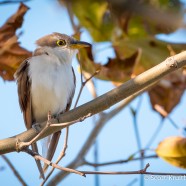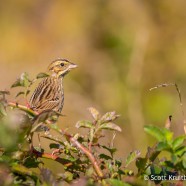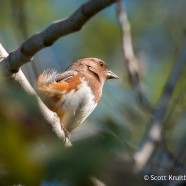Yellow-billed Cuckoo
This poor Yellow-billed Cuckoo (Coccyzus americanus) may have a prolonged pause in southbound migration this fall…why? Take a look. Something missing? It does not have a tail between those wing tips, and while it is out of view it looked like it was ripped right off. The bird is probably happy to be alive, and it was still observed feeding on autumn snacks such as a praying mantis. Hopefully it will be warm enough for it to survive for now and get on growing, perhaps taking an eventual slower and more methodical trip to its wintering grounds.
Read MoreLeucistic Savannah Sparrow
This appears to be a partially leucistic Savannah Sparrow, a migrant individual that I was surprised by yesterday morning. Leucism is when pigments are produced at less than normal levels or in an unexpected pattern. In this case many of the feathers on the head and throat do not have typical pigmentation. Interestingly the yellow patch on the face can still be seen, giving this unique bird an all the more fascinating look. Scott Kruitbosch Conservation & Outreach Coordinator
Read MoreVesper Sparrow
It took a while, but I finally got my fall Vesper Sparrows! My friend and sensational birder and naturalist Frank Mantlik found these two beauties in the Stratford community gardens among many other Song, Savannah, Swamp and White-throated Sparrows. They later cooperated, ever so briefly, for a couple photos. These big sparrows look so wonderful with those huge eye rings, and one was really showing off those white feathers… Scott Kruitbosch Conservation & Outreach Coordinator
Read MoreSavannah Sparrow
Masses of Savannah Sparrows are still on the move right now, pushing through our fields, grasslands, shrublands, farmlands and other open areas with significant food supplies and enough room to hide. Autumn allows you to study so many individual birds that show us how much variance there can be within what we call a species.
Read MoreFemale Eastern Towhee
Here is the female Eastern Towhee (Pipilo erythrophthalmus) looking well after a meal (note the bits left on the bill). She is being pushed by the cool northeast winds, her brown, orange and white feathers blowing a little in the breeze. That piercing red eye is magnificent! Autumn migration is a great time to find this bird, but you may also end up seeing them in the winter – especially if one comes to seek refuge at your feeders after a major snowstorm.
Read More








